Ladders are an integral part of many steel projects. Luckily, Advance Steel has a
Cage Ladder tool available for you. Making a ladder Advance Steel is a matter of two clicks and adjusting some parameters in the Cage Ladder dialog box.
Table of Contents
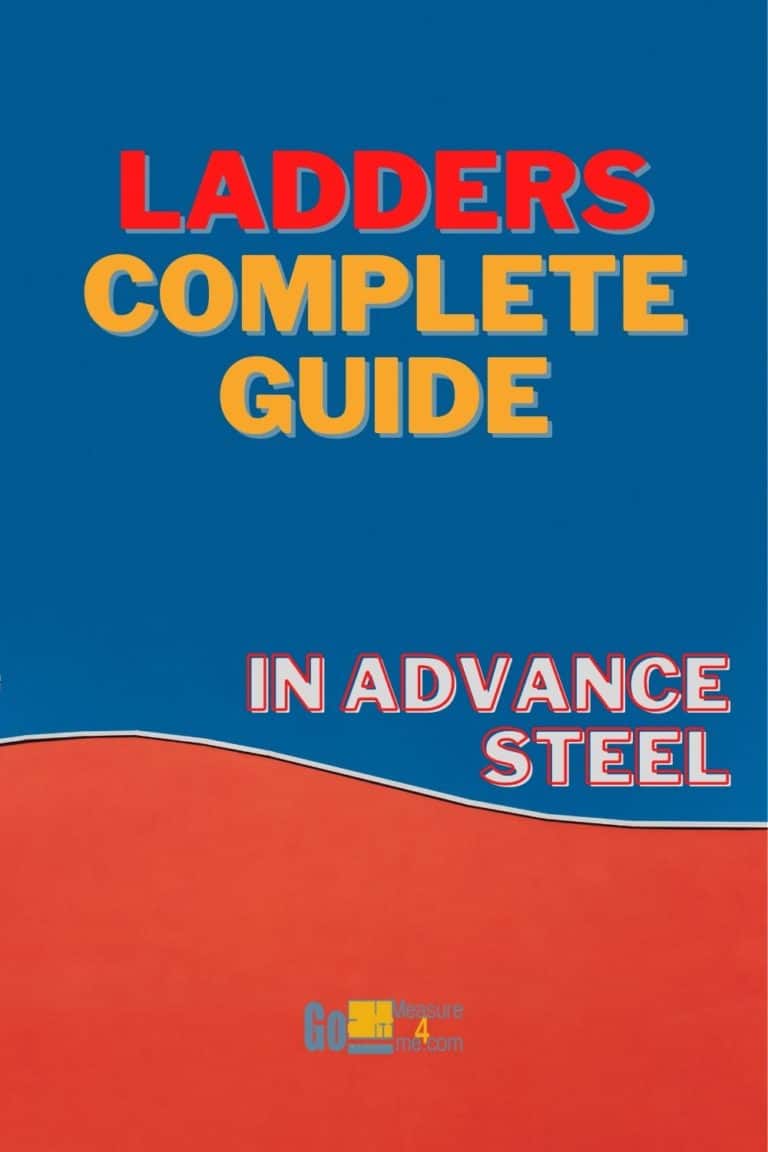
Accessing Cage Ladder Tool
You can access the Cage Ladder tool from Home and from the Extended Modeling ribbon tabs.
Accessing from Home Tab
Home tab > Extended Modeling panel > Cage Ladder

Accessing the Tool from Extended Modeling Tab
Extended Modeling tab > Structural Elements panel > Cage Ladder
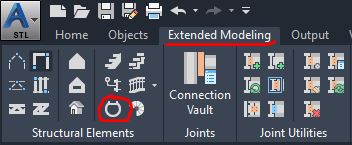
Important Sidenote About The Cage Ladder Tool And The Cage Ladder Rotation
The Cage Ladder was created with its bottom at the current UCS position and in the +XY quadrant. Because of that, in order to get the orientation right, you might have to rotate the UCS around the Z-axis in some cases. If you try to rotate the ladder after it is created, you’ll find that it’s not possible; however, you can move the ladder freely. So, before placing a new ladder, make sure your UCS is rotated correctly along the Z-axis. You can access the Z-axis rotation tool in the Advance Steel Tool Palette. Go to the Home tab:
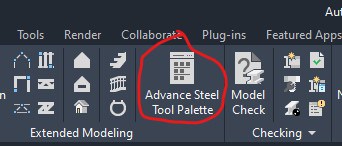
In the Advance Steel Tool Palette go to UCS section and Rotate along Z-Axis:

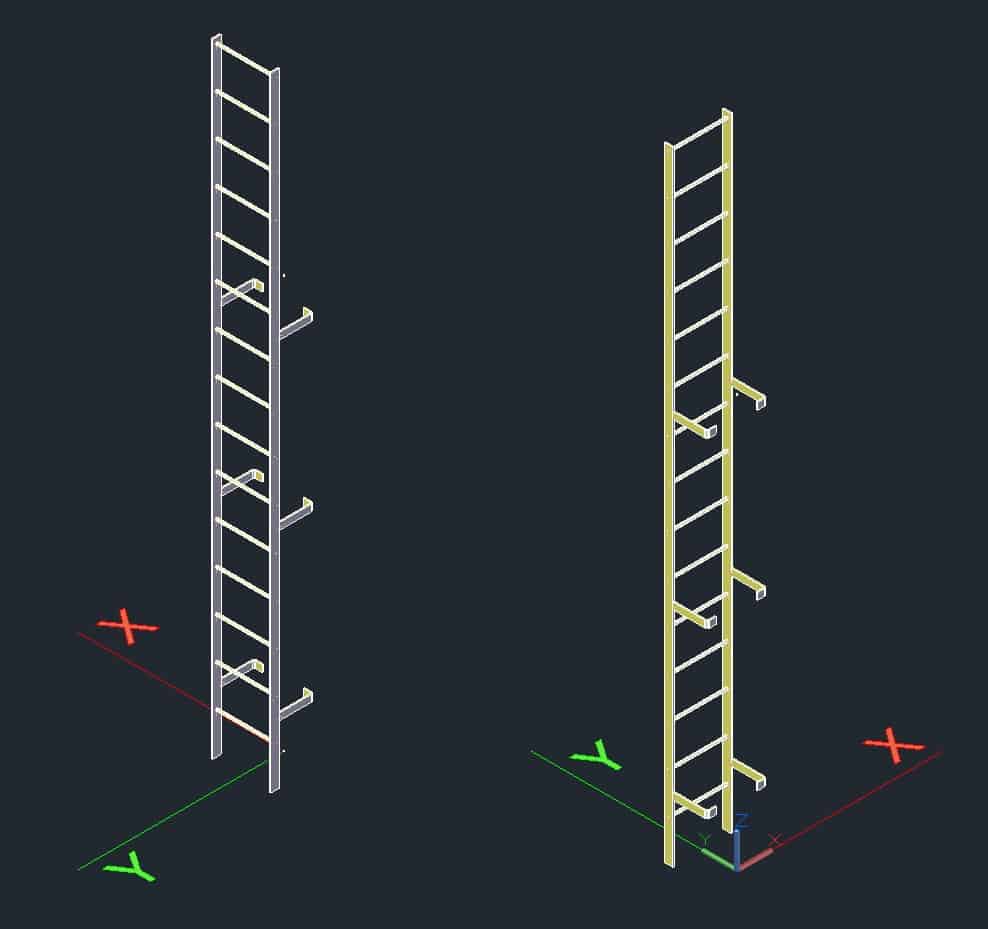
Cage Ladder And Simple Ladder
The Cage Ladder tool is not limited to cage ladders – you can also create simple ladders using this tool:


Starting the Cage Ladder Tool
When you start the Cage Ladder tool, you will be asked to select the start point of the ladder. The next thing, after specifying the start point, is to select the second point specifying the height of the ladder (this value can easily be changed in the dialog box later). Once you are done specifying those points, the dialog box will open where you can specify all the little details of your ladder:
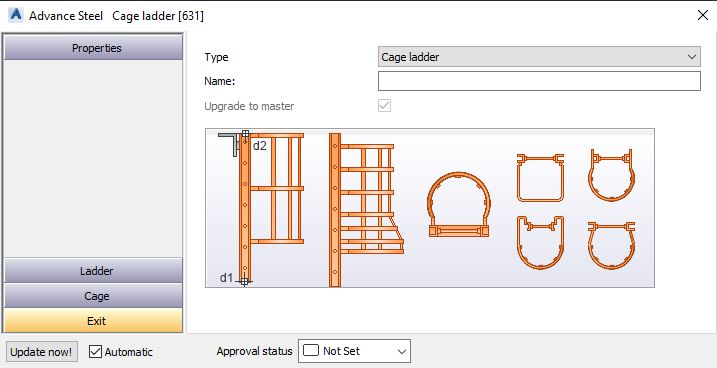
Here are the remaining categories:
Ladder Category
Ladder Category > Ladder
Specify all the ladder general dimensions:
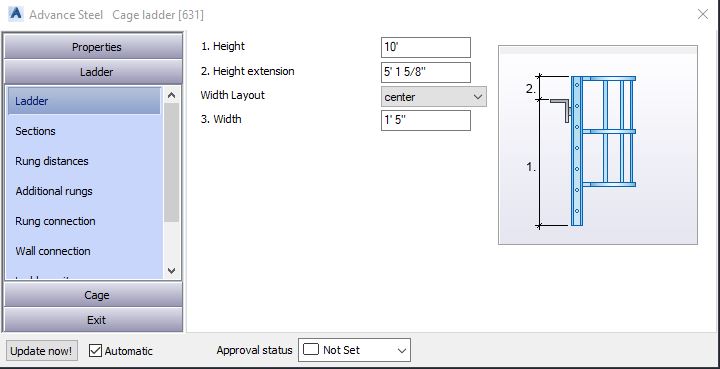
Height Extension
Specify the extension of the ladder at the top.
Width Layout
Specify the width of the ladder measuring options:
- from the inside
- outside
- center
of the stringers.
Width
Specify the width of the ladder. If the connection box of the ladder turns red after typing in the value, it means that the other values of the ladder do not comply with the specified width. In this case, adjust the values of the cage.
Ladder Category > Sections
Specify the type of ladder stringer sections and ladder rung:
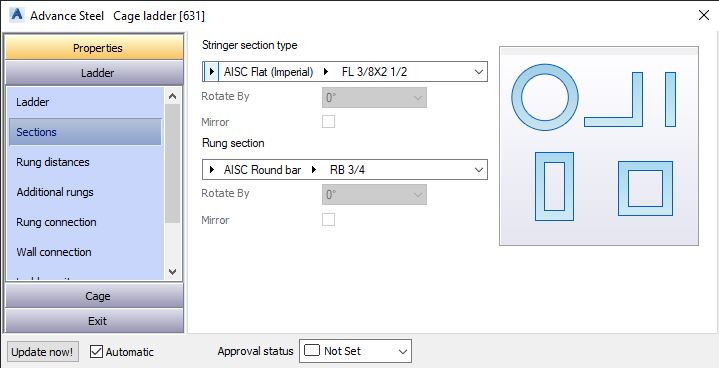
Ladder Category > Rung Distances
Specify the rung distances, distance layout, and position.
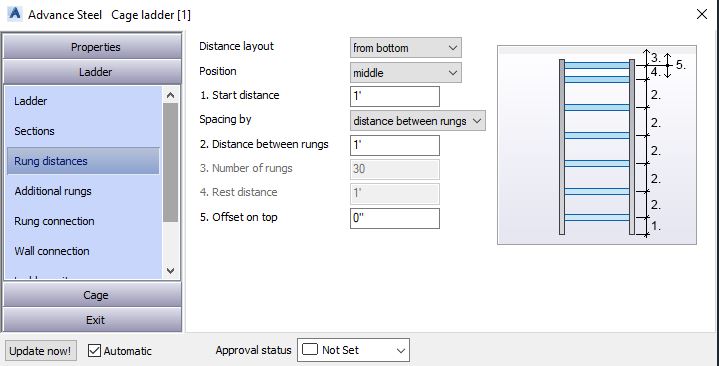
Distance Layout
Decide if the rung distances will be specified from the bottom, from the middle, or from the top.
Position
Decide if the rung position will be specified from the bottom or from the top.
Start Distance
Set the distance of the first rung.
Spacing By
Determine if the spacing of the rungs will be defined by the distance between rungs or the total number of rungs. If you select Number of Rungs, you can specify the total quantity of the rungs in the Number of Rungs edit box (also available below this drop-down list).
Rest Distance
Define the rest distance here.
Offset On Top
Offset the top rung if you wish. The positive value will offset the last rung upwards and negative – downwards.
Ladder Category > Additional Rungs
Determine if you wish to create additional rungs. This is usually required if you have extended the ladder using the Height Extension edit box in the Ladder tab.
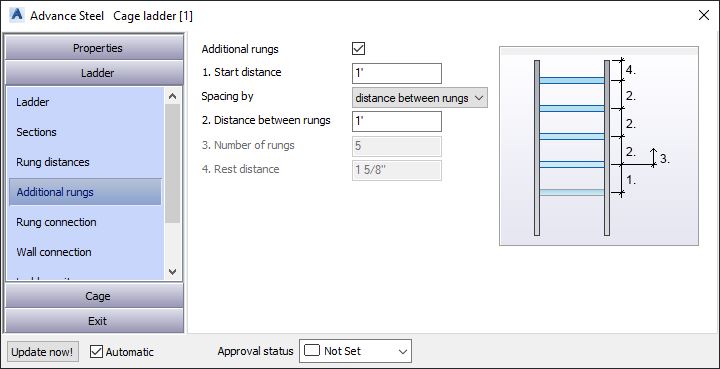
Additional Rungs
Determine whether or not the additional rungs should be created. By default, this option is not selected and the options in this tab are disabled. By selecting this option, you will enable all these options.
Start Distance
Define the start distance of the additional rung. This value will be calculated from the last rung of the ladder.
Spacing By
Determine if the spacing of the rungs will be defined by the distance between the rungs or the total number of the rungs.
Ladder Category > Rung Connection
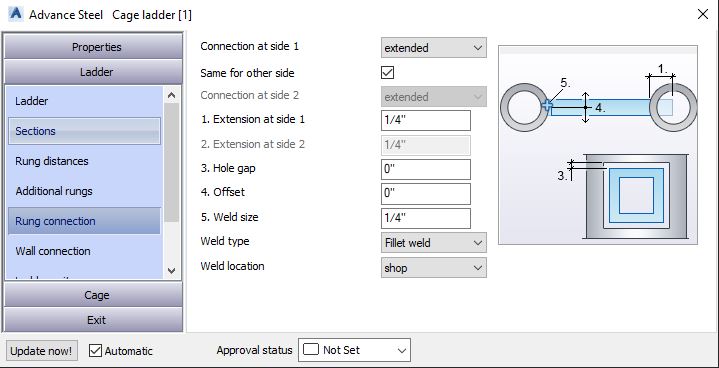
Connection At Side 1
Options available in this drop-down:
- Flush– guarantees the rungs are connected flush with the inside of the stringers.
- Straight– guarantees the rungs are connected straight to the stringers
- Extended– extends the rungs outside the stringers and the extension value can be specified in the Extension at Side 1 and Extension at Side 2 edit boxes. You can define the hole gap for the stringers in the Hole Gap edit box.
Same For Other Side
When selected, this box guarantees that the same connection is specified for the other stringer as well. This box is selected by default.
Offset
Offset the rungs from the middle of the stringers.
Ladder Category > Wall Connection
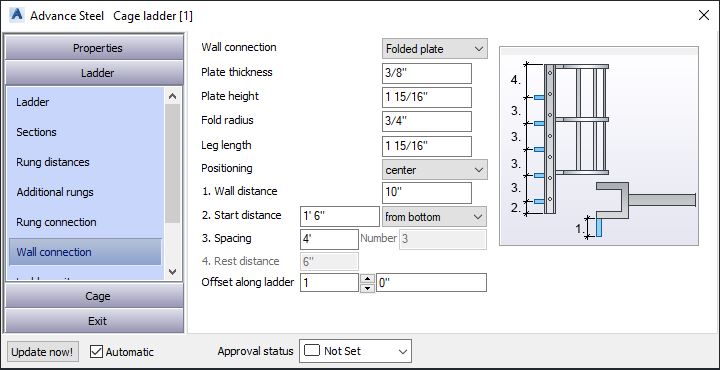
Wall Connection
Specify the wall connection type, which, by default, is selected to None and options in this tab are disabled as a result. Options available in this drop-down:
- Section – option selected to use a steel section to connect the ladder with a wall and you can select the section type and size from the Sectiondrop-down. Define distance in the Wall Distance
- Folded Plate– if selected – will be used as a section to connect the ladder to the wall. Define distance in the Wall Distance
- Plate– use a flat plate as a section to connect the ladder to the wall. The thickness and height of the plate can be defined here.
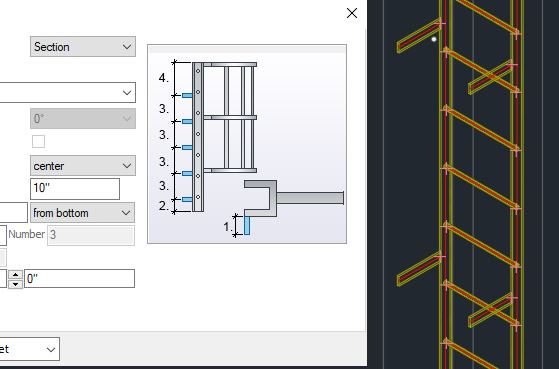
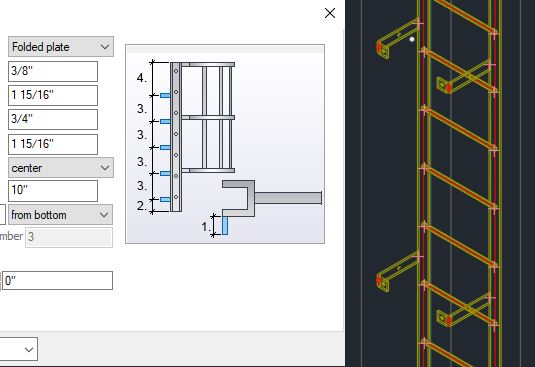
Positioning
Define the position of the connection sections on the stringer.
Start Distance
Define the start distance of your wall connections. You can choose from the options – from the bottom of the ladder or from the top.
Spacing
Define the spacing between the connecting elements of the ladder.
Offset Along Ladder
Offset the specified connecting elements along the ladder.
Ladder Category > Ladder Exit
Define all the parameters at the exit of the ladder.
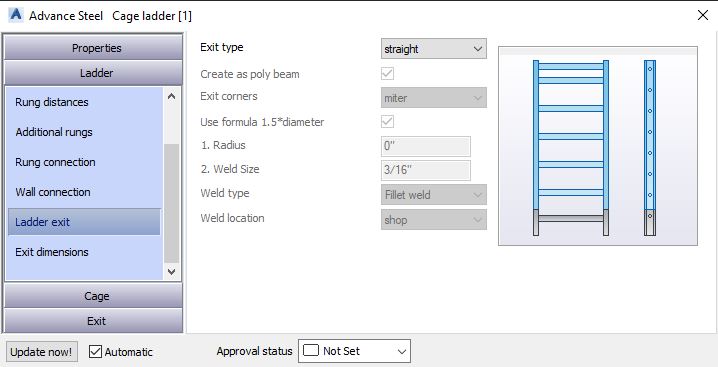
Exit Type
Specify the exit type of the ladder, which, by default, is selected at Straight, and as a result, all the other options are disabled. There are five more types of exits you can select from the drop-down:
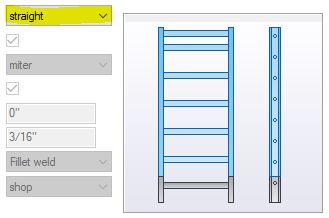
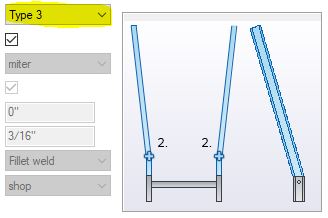
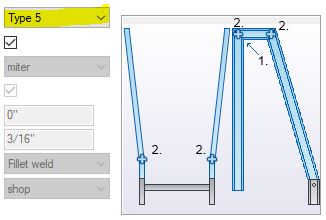
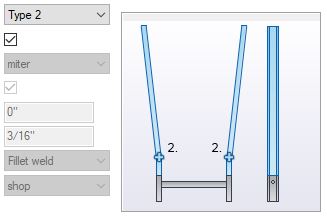
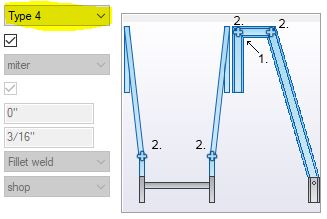

Ladder Category > Ladder Dimensions
The exit dimension options available in the Ladder Dimensions tab will vary depending on the exit type selected from the Exit Type tab.

Cage Category
Cage Category > General
Specify parameters related to the cage type:
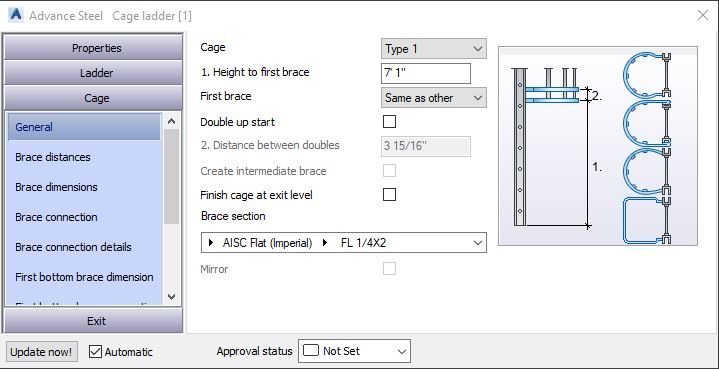
Cage
Define the type of cage you want to use (by default, None is selected and all the options are disabled). Examples of the cage type:

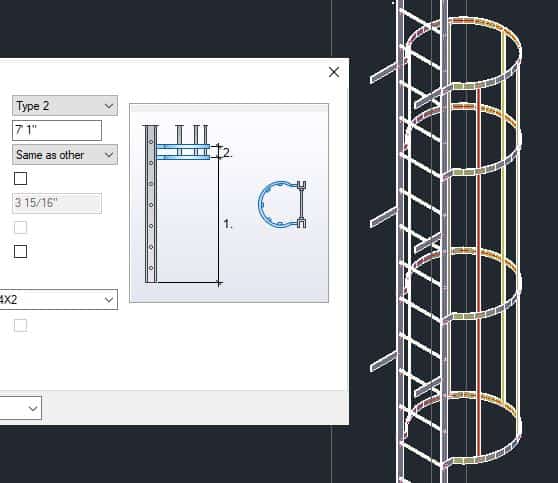
Height To The First Brace
Define the height to the first brace of the bottom cage from the bottom of the ladder.
Double Up Start
When selected, double braces will be generated at the start cage; then you can specify the distance between the two braces at the start by using the Distance Between Doubles box.
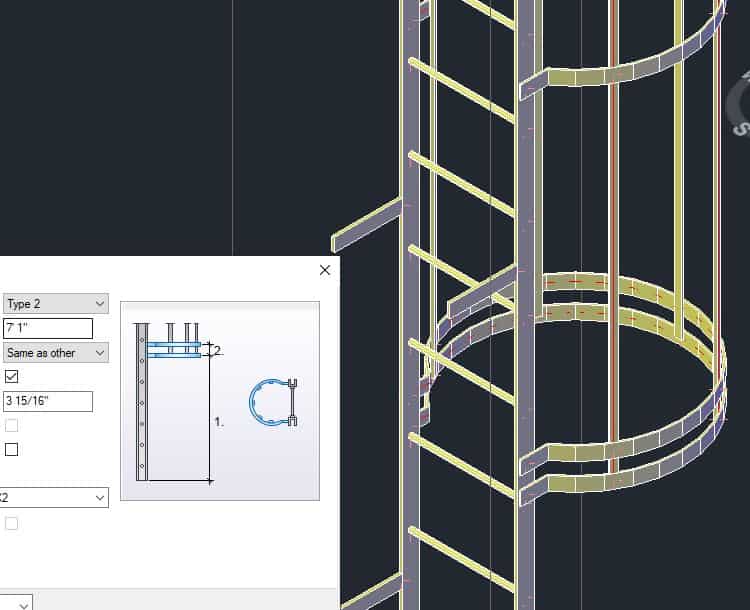
Create Intermediate Brace
Create an intermediate brace at the start.
Finish Cage At Exit Level
When you have extended your ladder using the Height Extension box in the Ladder Category > Ladder tab, you can finish the cage at the exit level by checking this box.
Brace Section
Specify the section of your brace.
Cage Category > Brace Distances
Define the brace distances.

Distance For First Brace Different
By selecting this option, you can specify a different value for the first brace. You can specify the distance between the first braces in the Distance Between First Braces edit box available below.
Distance 1st To Intermediate
Only available if the Create Intermediate Brace box is selected from the Cage category > General. Define the distance between the first and the intermediate brace.
Spacing By
Specify if the spacing between the braces will be defined using the distance between the braces or the total number of braces.
Offset At Top
Define the offset value for the top brace.
Cage Category > Brace Dimensions
Specify the brace size. When you select Create as Poly Beam, you will ensure that the brace is created as a single section. When you clear the check box, the straight curved sections of the brace will be created using separate sections that will be welded together.

Cage Category > Brace Connection
Specify if you want the braces to be welded or bolted to the stringers.

Cage Category > Brace Connection Details
Define the bolt or weld parameters of the brace connections.
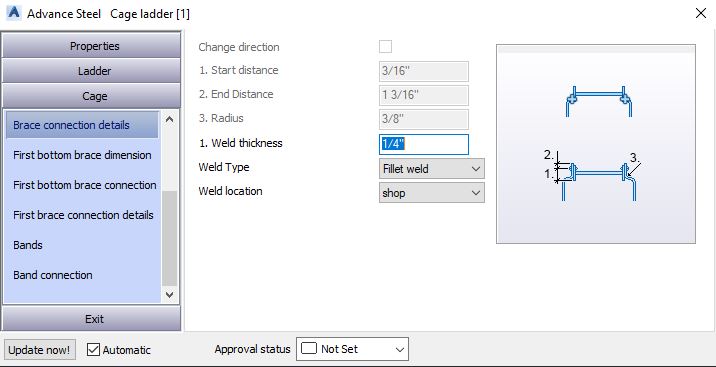
Cage Category > First Bottom Brace Dimension
Only available when you have not selected Same as Other from the First Brace drop-down in the Cage Category > General. If this is true, you can select different dimension values for the bottom cage. Generally, the radius of the bottom brace is larger than the other braces.
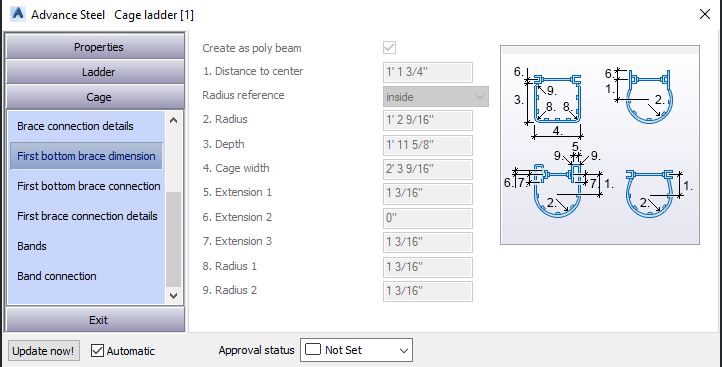
Cage Category > First Bottom Brace Connection
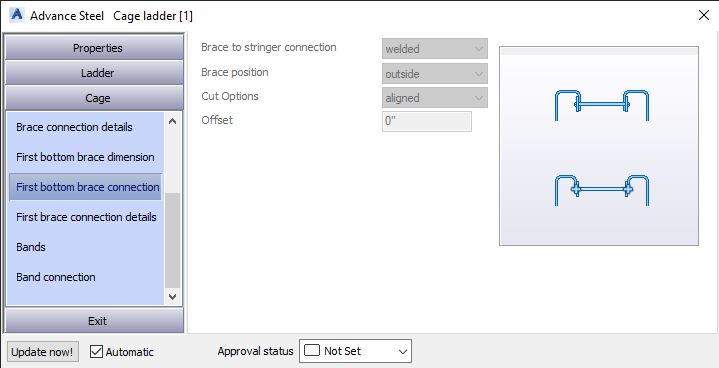
Cage Category > First Brace Connection Details
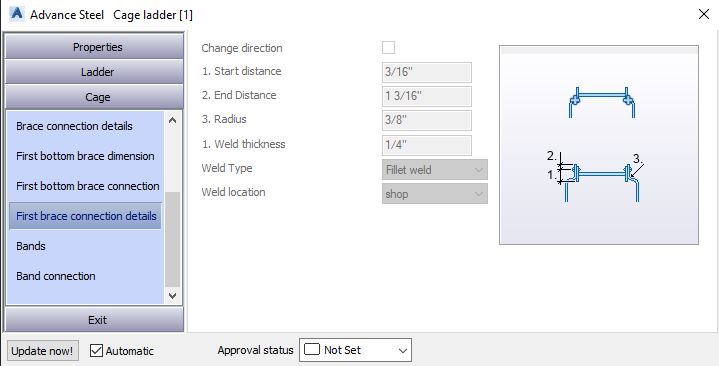
Cage Category > Bands
Define the band parameters.

Band Location
Determine if the bands should be located inside, outside, or in the middle of the braces.
Seperate Bands
Specify if you want single pieces of bands running between all the cages, separate bands per brace, or separate bands per cage.
If you want to control the bands independent of the bands of the rest of the cages, create separate bands per cage, especially when the cage ladder has a cage at the exit as well.
Gap
This box is available when you choose to select per brace or per cage from the Separate Bands drop-down. In those cases, you can enter the gap at the start and the end of the bands.
Band Sections
Define the type and size of the band sections.
Number on the Straight Part
Define the number of the bands along the straight part of the brace section.
Start Straight Distance
Define the start distance of the first band along the straight part of the brace section.
Straight Intermediate Distance
When you create more than one band along the straight part of the brace section, use this box to specify the intermediate distance between the bands.
Create Middle Band
Specify an even number of bands in the Number on Outside Part edit box. When you select this box, you will create a middle band as well, making the total number of bands on the outside part to be an odd number.
Number On Outside Part
Define the total number of bands required on the outside part of the brace section.
Angle
Define the intermediate angle between the bands on the outside part.
Cage Category > Band Connection
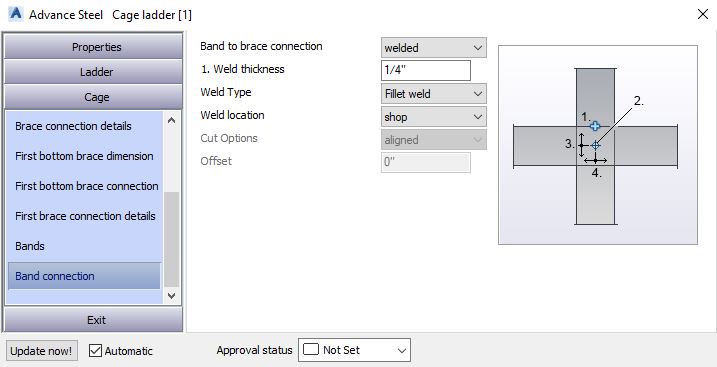
Exit Category
The options are similar to those discussed above; however, the options in the Top Cage and in the Opening Post are different.
Exit Category > Top Cage
Available only in the event that you decide to select straight ladder exit and also Finish Cage at The Exit Level check box from the Cage category > General tab.
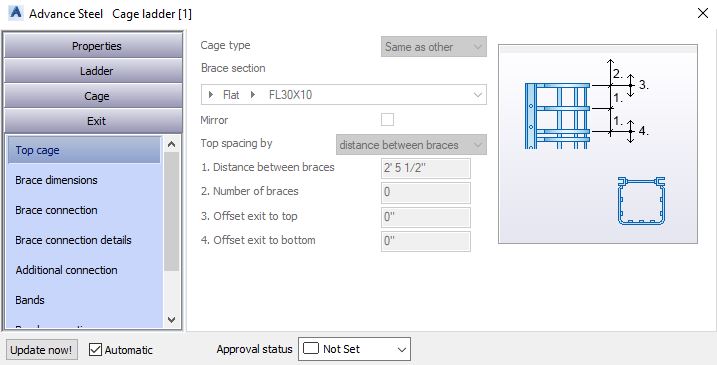
Define the top exit cage parameters. Most of the options in this tab are similar to those discussed above, except in the Cage drop-down list. You can select four types of cages and you also have the option to select the cage with the right or left exit.
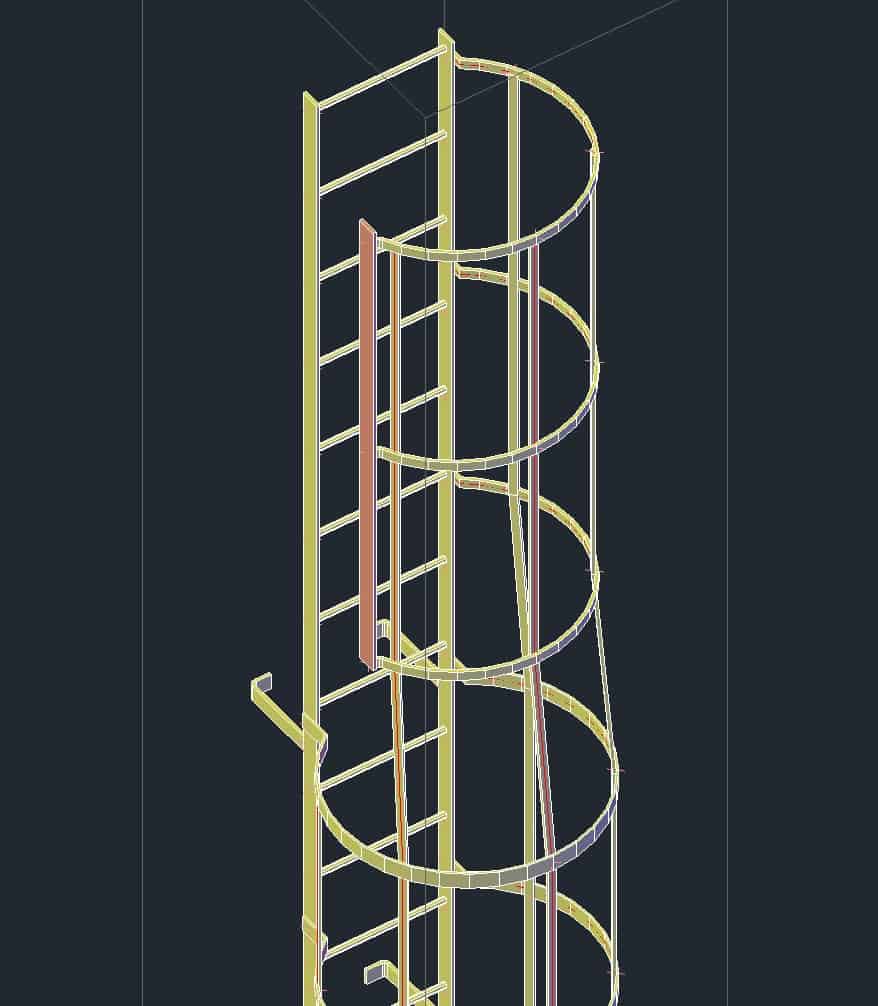

Exit Category > Brace Dimensions
Only available when you have not selected Same as Other from the First Brace drop-down in the Cage Category > General. If this is true, you can select different dimension values for the bottom cage. Generally, the radius of the bottom brace is larger than the other braces.
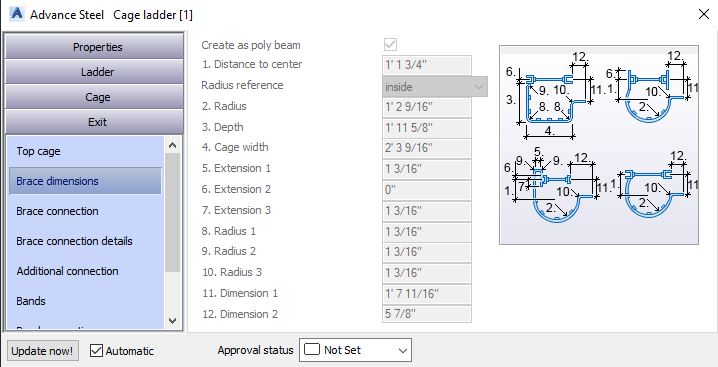
Exit Category > Brace Connection

Exit Category > Brace Connection Details

Exit Category > Additional Connection

Exit Category > Bands
Define the band parameters.

Exit Category > Band Connection
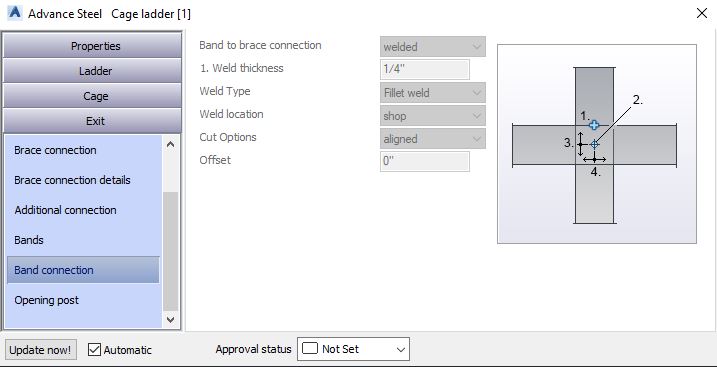
Exit Category > Opening Post
Only available when you select one of the cages with the opening from the Cage Type drop-down in the Top Cage tab.

Same As Stringer
If you wish to use the same section size and type for the opening post as that of the stringer, select this check box. If you clear this box, you can select a different size and type for the opening post from the Post Section drop-down.
Offset From Exit Level
Define the offset for the opening section from the exit level.
Height Layout
Specify how the height of the opening post will be specified:
- Same as Stringer– opening post terminates at the same level as the stringer.
- Distance from Brace– select this option to specify the height of the opening post in terms of its distance from the brace. The value can be entered in the Distance from Brace box available below the Height Layout drop-down.
- Total – specify the height of the opening post in terms of its total length value. You can define this value in the Height box available below the Height Layout drop-down.

